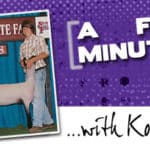
We caught up with judge Cade Wilson before he steps “Inside the Ring” at the State Fair of Virginia. We invite you to read our candid interview with Cade below and please continue to check back often for our next edition of “Inside the Ring.”
WHO GOT YOU INVOLVED IN THE LIVESTOCK INDUSTRY AND HOW?
I’d say my now wife Chelsea and Ag teacher (Chris Wiemers) are two of the main influencers in my life as far as encouraging my involvement in the livestock industry. There has be countless others along the way have shaped my viewpoints and challenged me as an evaluator.
WHAT IS A DREAM YOU HAVE ALWAYS WANTED TO ACCOMPLISH?
Fish in the Bassmaster Classic…..
WHERE ARE YOU FROM AND WHAT BROUGHT YOU TO WHERE YOU CURRENTLY LIVE?
I currently live in Early, Texas. My job as an Ag Science Teacher brought me to my current residence.
WHAT IS A PET PEEVE OF YOURS IN THE RING?
Pushing sheep out in front of others on the profile is something I don’t appreciate. I think sportsmanship is really important and when you do that you have little regard for those around you.
WHAT’S YOUR FAVORITE SHEEP YOU’VE EVER SEEN?
There are a couple that really stand out. Funny as I think about it both have come from the State of Colorado. The winner of The Colorado State Fair and Denver I really thought were special!
DO YOU HAVE A FAVORITE ROAD TRIP SNACK?
Snuff and Sunflower Seeds
SHOWING BY WEIGHTS OR BY BREEDS?
Breeds
STATE FAIRS OR NATIONAL SHOWS?
State Fairs
EVALUATING STOCK ON THE MOVE OR ON THE PROFILE?
On the Move

This edition of A Few Minutes is with Cade Wilson, the market lamb judge of the upcoming North American International Livestock Exposition. He currently lives in Levelland, Texas with his wife of five years, Chelsea, and their three year old daughter Tynlea. They also recently found out that they have another addition to the family on the way. Cade is an instructor and livestock judging coach at South Plains College.
Where did you attend college?
I attended junior college at South Plains and senior college at Texas A&M.
Any accolades while you were there?
While at South Plains, we finished fifth at Houston and at Texas A&M we won the National Championship at NAILE in 2004. As an individual, I finished in the top ten at every national contest.
Everyone who judges has that one card they wish they could go back and remark. Where would that have been for you?
The Hamp ewe class with a club lamb scenario at NAILE. I had it marked a fifty in the first minute of looking at the class. I read the scenario again and thought too much about it. My top pair and bottom pair were close and I changed it at the last minute and ended up taking a double pair switch on the class. It cost me seven points and I lost the contest by six.
What do you hope that the kids that are judging for you take away from their experience?
Well, most of them don’t end up going into agriculture production necessarily, so I hope they take some other skills away from the experience. I certainly think it builds character, work ethic, and communication skills. It also teaches them to work together as a group. I hope these things transfer over to their occupations. It’s important that they take more of the life lessons away from the experience, rather than just livestock evaluation skills.
Who’s your favorite band?
Can I name a few? Robert Earl Keene, Cory Morrow, Kyle Park, Reckless Kelly, and Roger Creager would have to be on my list.
What’s your experience with the sheep industry?
I showed sheep throughout high school. My father was an ex agriculture teacher so I had always been exposed to it, but didn’t actually start showing them until high school. Since 2005 I have been in partnership with Gary Cash, running around 150 Hamp cross ewes.
What are your initial sorts when evaluating market lambs?
My first sort would be muscularity, but once I consider them adequate in that regard I sort quite a bit more on the build of the lamb.
When you get down to those top end lambs, what separates them for you?
I place emphasis there on quality of the lamb, and I realize that is a broad statement, but for me the hardest ones to make are ones that are complete and fault free. I want to see a quality look for the side as well, but I’m just not big on extremes, rather in just finding livestock that are complete. Some judges have started walking lambs a lot more, and I certainly will move them quite a bit as well and I think that is where you get the truest read on one, when they are loose.
What would you consider an acceptable fat range?
.15 – .25, but it’s most important to me that they are fresh and have an appropriate amount of finish for their division or class. I would rather see a fresh lamb with the right amount of fill, than a bigger lamb that is pulled down too far. Too be fresh in their handle is real important to me and I would probably lean toward the upper range of that fat range if needed to get one fresh.
One current trend in the market lamb industry is toward an increased bone and foot size. What is your take on this?
When they have an acceptable bone and foot size that looks proportionate to the body so that they do not appear frail I think that is enough. There may be some economical impact from a show lamb industry standpoint, but there is no real advantage in the actual market lamb industry. There is no reason to beat one that is adequate in its bone and excels in other attributes, just because a lamb is extreme in its bone size.
Another place of emphasis has been on analyzing the chest floor in show lambs. What is your input on the importance of this in market lamb evaluation?
I’m pretty big on studying chest width and rib shape because it is the foundation for top shape. More often than not a wide foundation relates to extra dimension and width up top. They can be as pulled apart and as wide as you can make them, so long as they still have a neat look at the base of their shoulder. I certainly don’t want them bulky and round fronted.
Who are some people that you credit with helping you get to where you are today?
There are two people that helped me out a lot along the way that I still look up to today and value their opinion. One would be my high school agriculture teacher Chris Wiemers and another would be my father-in-law Jackie McDonald. I really look up to Kyle Smithwick. I think he is a stand-up kind of guy and a great evaluator of livestock. My two college livestock judging coaches helped me out a lot and I’m still good friends with both of them. At South Plains that was Dave Clevenger and at Texas A&M that would have been Ryan Rathman. They both see the value of not just being competitive, but more so building relationships with people to depend on later in life.
What do you consider an acceptable weight range in market lambs this time of year?
I’m pretty liberal in terms of acceptable weight ranges. I think sometimes you can back yourself into a corner if you say there is an exact window that a champion has to fall into. More importantly I want sheep to look youthful and realistic in terms of frame size for their given weight division. Using what I deem to be the best one there and not being concerned that they fit a given weight range will be what truly makes it a fun day.
















